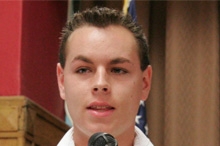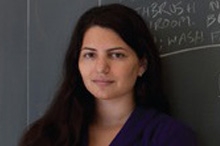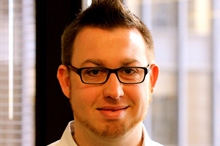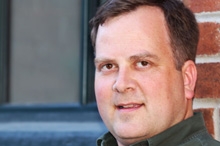Champions of Change Blog
The Power of Community: Embracing “It Takes a Village to Raise a Child” in Policy Development and Service Design
Posted by on August 15, 2013 at 1:56 PM EDT Zach Garafalo is being honored as a Champion of Change for embodying the next generation of leadership within the disability community and his commitment to the promise of the Americans with Disabilities Act.
Zach Garafalo is being honored as a Champion of Change for embodying the next generation of leadership within the disability community and his commitment to the promise of the Americans with Disabilities Act.My personal story could have had a very different outcome. I was adopted at four months. From the outset, I displayed all the behaviors consistent with Attention Deficit Hyperactivity Disorder (ADHD). Think a bicycle missing its brakes. My bicycle also did not have any wheels, any steering or any chain. I was literally bumping around out of control in every direction. In Kenneth Grahame’s The Wind in the Willows, I was Mr. Toad. When I was two and a half years old, I was formally diagnosed with ADHD.
My parents’ connection to the broader adoption community of support enabled them to learn about and access an array of services to assist in my pro-social development. Over many years, my parents wove together various interventions, summer camp, social skills groups, counseling, sports that helped me develop the insight and ability to compensate for and manage my excess energy. The unifying theme for my parents, and eventually me, was connecting with others to learn what resources existed.
I have always had positive adult role models. Role models do not need to be educated parents or helping professionals. Connectedness and inspiration can come from unconventional places and be equally transformative. Teachers, community leaders, custodians, coaches and others devoted time to help nurture my passion for civic involvement and volunteerism. Caring adults took the time to mentor and help shape my leadership capacities. I served as Student Representative to the Natick School Committee, Chairperson of the Youth Advisory Board and youngest elected Town Meeting Member in Natick’s history. My deficits never defined me. I write this not to boast, but to inspire hope and to personally illustrate that people with disabilities do not have to be defined by their challenges.
I attended Southern Vermont College in Bennington, the kickoff site for the President’s 2020 College Completion Initiative. My college experience helped prepare me for a smooth transition into a great career and graduate studies. The Success Center allowed me to understand my strengths and areas for growth as a learner and equipped me with skills to compensate. What is remarkable about SVC is the community ethos that charges its students to think critically and challenge the status quo. Today I am challenging the status quo.
My personal story informs my work. This is why I get up every day and fight for the rights of all young people. My own lived experience – supported by research – has clearly documented that young people and families who are connected to their communities have better long term outcomes. We need to invest in children and families and work toward building a unified system where young people and those who care for them have knowledge of and access to services that form a cohesive whole as opposed to a fragmented hole. Empowering those who care for young people to navigate complex and multiple overlapping systems is vital.
Zach Garafalo is the Assistant Director of YOUTH POWER!
Learn more about Civil Rights, DisabilitiesDay of Mourning: Affirming the Value of Disabled People’s Lives
Posted by on August 15, 2013 at 1:47 PM EDT Zoe Gross is being honored as a Champion of Change for embodying the next generation of leadership within the disability community and her commitment to the promise of the Americans with Disabilities Act..
Zoe Gross is being honored as a Champion of Change for embodying the next generation of leadership within the disability community and her commitment to the promise of the Americans with Disabilities Act..I had a lot in common with George Hodgins. He lived in a quiet suburban neighborhood an hour or so away from the quiet suburban neighborhood where I grew up. We were both autistic, very close in age, both struggling with our transitions to adulthood and independent living. We both had interests we were passionate about. I was absorbed in disability advocacy whereas George was more athletic, preferring hiking and soccer. I was on leave from college last spring; George’s parents had recently withdrawn him from a local day program he attended.
The first point of difference between George and me: I will turn 23 this fall. George never will.
On March 6, 2012, George Hodgins was murdered in Sunnyvale, California. His mother, Elizabeth, shot him point-blank, and then killed herself.
Journalists covering the event for local papers called George “low functioning and high maintenance.” They called Elizabeth Hodgins “a devoted and loving mother.” They sought out quotes from other parents of autistic children, who normalized the crime by saying things like “every mother I know who has a child with special needs has a moment just like that.” Many people commenting on these articles also expressed sympathy for the mother, calling her a “guardian angel.” Many said her decision to kill George was “understandable” because autistic children are difficult to parent, because there aren’t enough services for families, or because given his disability and an assumption that he could not have enjoyed life anyway.
Reading these things, I felt alone in my mourning. There seemed to be an outpouring of grief and sympathy for the murderer, and far less sympathy for the victim. The ideas being expressed about autistic people, and people with disabilities, frightened and upset me. So I reached out to my community, and we grieved together. Working with the Autistic Self-Advocacy Network, Not Dead Yet, and the National Council on Independent Living, I started Day of Mourning, a nation-wide vigil commemorating the lives of people with disabilities murdered by their parents or caregivers.
I feel strongly that prejudice and ignorance about people with disabilities leads to these murders, and to the crafting of sympathetic messaging around them. Because so many people in our society can’t imagine a person with disability living a fulfilling life, they don’t see the tragedy and the wasted potential when one of our lives is cut short. How do we communicate that the lives of people with disabilities have actual value? All too often, society grieves over the existence of people with disabilities, mourning our lives instead of our deaths.
The Day of Mourning vigils represent a stand against these prejudices, and an affirmation of the value of our lives as people with disabilities. They serve to challenge the prejudiced way these murders are covered in news media, and support the need for true justice for crimes perpetrated against people with disabilities. The vigils allow people with disabilities to come together as a community and a culture, to support each other and to remember our dead. Most of all, the Day of Mourning vigils ensure that George Hodgins and others like him will be remembered as they deserve – not as burdens or as tragedies, but as people whose lives mattered.
Zoe Gross is a Patricia Morrissey Disability Policy Fellow at the Institute for Educational Leadership.
Learn more about Civil Rights, DisabilitiesKeeping the Promise of the ADA: Unequal Justice for Disabled Victims of Murder
Posted by on August 15, 2013 at 1:32 PM EDT
Lydia Brown is being honored as a Champion of Change for embodying the next generation of leadership within the disability community and her commitment to the promise of the Americans with Disabilities Act.
Generations of disability rights activists, in bipartisan partnership with policymakers, have made great strides toward fulfilling the ADA’s promises of equality of opportunity, full participation in society, independent living, and economic self-sufficiency. Yet keeping the promise of the ADA also means confronting the difficult and uncomfortable reality that people with disabilities continue to be disproportionately victimized by abuse and violence.
Since I began advocating for disability justice in 2009, I have learned that violence has permeated every part of disability history. People with disabilities were targeted for elimination during the Holocaust under Nazi Germany, forcibly sterilized under the Constitution in Buck v. Bell (1927), a decision that has never been overturned, and repeatedly rejected for life-saving organ transplants solely on the basis of disability without any legitimate medical reason.
Are the names Daniel Leubner, Angelica Auriemma, and George Hodgins familiar to you? If you don’t know their stories, I suggest you google them. Each of these people were killed by those that were supposed to care for them, and in each case, the victim’s disability was the motivating factor in the commission of the crime. Daniel, Angelica, and George were all autistic, as I am. The horror of their murders is regularly compounded by dehumanizing and devaluing rhetoric, empathy for the aggressors rather than the victims, and misrepresentation in the media, in public discourse, and in policymaking discussions.
I have testified against the abuses by the Judge Rotenberg Center in my home state of Massachusetts, where six residents with disabilities died because of violent aversive “treatments.” I have written proposed legislation in Massachusetts demanding a regulatory response to continued police brutality that has caused the deaths of fellow autistic Americans. I have campaigned against the use of restraints and seclusions in school, which have been cited many times by the U.S. Government Accountability Office in testimony before Congress as the cause of death for many students with disabilities.
Hate crimes against people with disabilities demand a response from all communities in order to combat the insidious attitude that our lives are less valuable and not worth fighting for. As long as people like me can be killed for the crime of inhabiting atypical bodies and minds and as long as those responsible can escape any real consequences for their crimes, neither I nor my children nor my children’s children will be free to achieve equality of access and opportunity.
The specter of violence remains an enormous obstacle to equal rights for Americans with disabilities. Until we begin to have serious discussions about the ramifications of violence against people with disabilities and what we can do to implement policies and foster communities that respect and affirm people with disabilities, these realities will remain ensconced in shadows. How do you get rid of shadows? Expose them to the light. That’s what true champions of change have always done and, together, we’ll do the same here.
Lydia Brown is the Undersecretary for Disability Affairs in the Georgetown University Student Association and Project Assistant for the Autistic Self Advocacy Network.
Learn more about Civil Rights, DisabilitiesUniting technologists and community leaders to help solve civic problems in Chicago
Posted by on August 14, 2013 at 5:32 PM EDT
Christopher Whitaker is being honored as a Champion of Change for applying his tech skills for civic good.
In early 2009, I joined the Illinois Department of Employment Security as a program representative at a field office in Chicago. The bottom had dropped out in the economy and our office was packed to the brim with people who - through no fault of their own - had been laid off from their jobs.
So, on my first day of work I showed up, went to my desk, and booted up a system that was built in 1973. It was a DOS-based system that didn’t process anything that I entered in until evening. In order to learn if what you did the previous day worked, you had to go line by line through a report that printed out on a ream of paper every morning. Given the vast scope of the economic crisis and its impact on everyday residents, I was expecting to have the tools needed to help unemployed residents.
There’s a glaring gap in technology between the private and civic sectors. This is exceedingly frustrating as government and community non-profit organizations are tasked with solving big problems that affect residents on a daily basis. I’ve been fortunate to be a part of a movement to help fix these problems in my role as both the Code for America Brigade Captain for Chicago and as a project manager for the Smart Chicago Collaborative.
There is a lot of work being done in Chicago to advance civic innovation. When Mayor Emanuel came into office in 2011, he hired John Tolva and Brett Goldstein to help release city data and to advance the city’s digital infrastructure. With the wealth of data now being released by the city, civic technologists are able to turn this data into civic apps like Schoolcuts.org, Chicago Councilmatic, and Clearstreets. Many of these apps are built at the weekly OpenGov Hack Nights hosted every Tuesday night by Derek Eder and Juan Pablo-Valez inside Chicago’s 1871 coworking space. Tom Schenk Jr, Director of Analytics at the City of Chicago, is a constant presence at the hack nights, helping civic developers with questions they have about city data. In the past few years, we’ve made tremendous progress at using open data to help our communities.. We’re taking the lessons that we’ve learned during these hack nights and spreading them to other cities through the Code for America Brigade program.
At Smart Chicago Collaborative, we’re accelerating this effort by collaborating with civic developers, government departments, and community organizations to produce more complex civic apps that will have a larger impact. The Smart Chicago Collaborative works to use the transformative power of technology to spur civic innovation in Chicago. These efforts include supporting apps like Foodborne Chicago, which listens to Twitter for cases of food poisoning in Chicago. We use those interactions to then submit a 311 request to the Chicago Health Department so that restaurant gets inspected - resulting in a healthier Chicago. We’re also testing these apps through our Civic User Testing group. The Civic User Testing Group has recruited testers all over the city to help ensure the civic apps developed here are both user-friendly and actually solving problems.
Civic problems are complex in nature. Given the drastic cuts to social services in the last few years, it will take more than a few cool apps to help solve these issues. However, by fostering collaborative partnerships between technologists and the civic sector, we can make a big impact in our communities.
Christopher Whitaker is a Project Management Consultant at the Smart Chicago Collaborative
Learn more about TechnologyCivic Hacking Our Way to a Better Government and Stronger Democracy
Posted by on August 14, 2013 at 5:06 PM EDT
Steve Spiker is being honored as a Champion of Change for applying his tech skills for civic good.
I’m an immigrant. I may not look like it, but I came to the USA for love and I’ve grown to seriously love this country in spite of its flaws. I’ve been blessed to work for a social justice organization (Urban Strategies Council) in Oakland, California, and have loved serving the city and its residents. I’ve devoted myself to helping make data-driven decisions a reality but have realized the parallel need for more civic engagement on behalf of our city and our residents. I’m also a tech geek and have benefited from proximity to the amazing people of the Bay Area tech community.
Despite all the great efforts of many community-based organizations and government agencies, we haven’t made much of a dent in poverty and inequity in the Bay Area. My reaction to this failure is that we must do things differently and do them better if we want to see social change. A big piece of this change is that our cities must become more open, more engaged, and more agile. At the core of so much failure is the way we strategically use (or don’t use) data and technology in local government.
Being part of the civic innovation community has been an amazing and humbling experience. It has taught me that there are always others with ideas as good, or better, than my own. The diverse members of OpenOakland, our volunteer organization that I co-founded with Eddie Tejeda in 2012, represent a broad group of technologists, activists, researchers, designers, and residents who believe that our city can and must be better. We’re working to build better interfaces to government that make interaction with government simple and painless. We’re leading the way with effective public-private partnerships and with collaborations that gently move our government to a more accessible, more agile, future.
Great work has been done in other cities to make governments more open and effective and I’ve shamelessly sought to bring those great practices home to Oakland. I’m not the most creative person in the world. I’ve been called an innovator but really I just find great solutions that others have invented and apply them to our local problems. This is the heart of civic hacking for me: building new solutions and processes to replace broken ones, sharing our lessons and our successes and allowing others to benefit from our knowledge, failures, and shared technology. The way open-source technology is created lends itself incredibly well to the way we recreate our cities — openly, collaboratively, and for the good of all.
Through OpenOakland we’ve begun work reshaping civic engagement through our CityCamp Oakland and supported civic hacking efforts with our Open Data Day and Code for Oakland Hackathons. More recently we held an incredible collaborative event called ReWrite Oakland as part of the National Day of Civic Hacking where over 70 people worked together to build something new and creative for our city. In one day our community and the city together built a system called Oakland Answers- a new way of helping residents find the information they want. The system, built on open source technology first developed in Honolulu, gives people a Google style search interface that helps them find simply written content fast and painlessly.
I’m proud to be part of the Code For America family and to have such a strong network of leaders and doers across the country who are working to transform government to be truly by the people, for the people. We need to restore trust in government and respect for public service — to create a strong platform on which to build our future. I think we’re slowly moving the needle on this in Oakland.
Steve Spiker is the Director of Research & Technology at the Urban Strategies Council
Learn more about TechnologyA Chance to Imagine the Possibilities
Posted by on August 14, 2013 at 4:40 PM EDT
Scott Phillips is being honored as a Champion of Change for applying his tech skills for civic good.
Leading up to the National Day of Civic Hacking (NDoCH), the Code for Tulsa team worked hard to produce an amazing event. Twelve days before our event, a massive EF-5 Tornado ripped through Moore, Oklahoma leaving a trail of destruction over a mile wide and 17 miles long. In the wake of the disaster, we struggled with an appropriate response and even considered cancelling our event. Our concern turned to opportunity when Open FEMA contacted us and offered their resources. We realized we could build something at our hackathon that could help in future disasters. With this project we could honor those impacted by the tragedy and turn our sorrow into action.
Subsequent brain storming led me to the orange spray paint X’s that were used to identify searched buildings after a disaster. I remembered seeing the process repeated each time our country had a disaster and thinking how inefficient it was and how easily technology could improve this process. Code for Tulsa had developed a map project for the Tulsa Fire Department and I knew we could build something that could help in a disaster.
Based on this idea, we worked with Open FEMA, the Oklahoma All Hazard Incident Management Team, and Oklahoma Task Force 1, our state-run Urban Search & Rescue (US&R) Task Force, to develop a basic design spec that came together the morning of our hackathon. Both the Oklahoma Incident Management Team and Oklahoma Task Force 1 had just returned from their deployment to Moore, so they brought incredible real world perspective.
Shortly after our hackathon, Open FEMA also connected us with an NDoCH team in Rockaway Beach, NY that was working on disaster response challenges from Hurricane Sandy. As soon as we saw the incredible overlap in our visions both teams decided to collaborate
The Open Search & Rescue Map Project we subsequently built is an HTML5 mobile web app for use by First Responders and US&R personnel during all phases of a major disaster response. Its primary use is to augment the orange spray paint X’s with virtual X’s on geo-located maps that can be viewed on smart phones, tablets and other devices. The app allows search personnel to use any mobile device to virtually X the start of a search, the end of a search, and to document victim findings, hazardous conditions found, and building condition. The app also has advanced map layering features that allow search teams to turn on or off layers that include geo-located post disaster aerial imagery, previous search findings, and locations of other teams and search & rescue assets. The project also allows commanders at the Base of Operations (BOO) to track all of the US&R teams in the field simultaneously giving them real time map based situational awareness in addition to real time search progress monitoring. In aggregate all of the features allow US&R teams to deploy faster, and search more efficiently saving precious time and potentially even lives.
As inspiring as this project sounds, the real take away is how well it illustrates the story of Civic Hacking and hints at its true potential. Over the period of a few days a Federal agency was able to connect with a group of civic minded volunteers who then connected with two different state organizations and ultimately, a team half way across the country. The resulting collaboration led to a tool that actually has the potential to save lives.
Pivotal to that success was a culture of people feeling they had enough ownership to inspire meaningful action. Government in America can feel so large and distant that people often do not feel that they can make a difference. The Civic Hacking movement not only shows people that they can, it actually lets them.
The ultimate potential for this is seen when we extrapolate this story to all facets of government. The easiest way to consider this is to view it in three steps; give citizens transparency, give citizens a voice, then give citizens ownership. I can only imagine the possibilities.
Scott Phillips is the Co-Founder and CEO of Isocentric Networks
Learn more about Technology
- &lsaquo previous
- …
- 45
- 46
- 47
- 48
- 49
- 50
- 51
- 52
- 53
- …
- next &rsaquo
White House Blogs
- The White House Blog
- Middle Class Task Force
- Council of Economic Advisers
- Council on Environmental Quality
- Council on Women and Girls
- Office of Intergovernmental Affairs
- Office of Management and Budget
- Office of Public Engagement
- Office of Science & Tech Policy
- Office of Urban Affairs
- Open Government
- Faith and Neighborhood Partnerships
- Social Innovation and Civic Participation
- US Trade Representative
- Office National Drug Control Policy
categories
- AIDS Policy
- Alaska
- Blueprint for an America Built to Last
- Budget
- Civil Rights
- Defense
- Disabilities
- Economy
- Education
- Energy and Environment
- Equal Pay
- Ethics
- Faith Based
- Fiscal Responsibility
- Foreign Policy
- Grab Bag
- Health Care
- Homeland Security
- Immigration
- Innovation Fellows
- Inside the White House
- Middle Class Security
- Open Government
- Poverty
- Rural
- Seniors and Social Security
- Service
- Social Innovation
- State of the Union
- Taxes
- Technology
- Urban Policy
- Veterans
- Violence Prevention
- White House Internships
- Women
- Working Families
- Additional Issues

